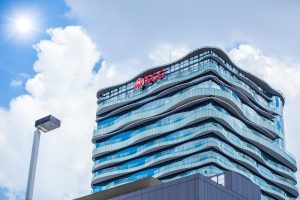Dr. Alvin Camba, assistant professor at the Josef Korbel School of International Studies, recently published a journal article highlighting a complex nexus between infrastructure-led development, climate policy, and building materials like cement. When countries like Indonesia and the Philippines build physical infrastructure such as roads, dams, and airports, they use large amounts of cement. And the process of making cement requires kiln temperatures of up to 2,700 degrees Fahrenheit, meaning enormous amounts of energy are involved. The economics of cement production, particularly in emerging markets, are thus highly intertwined with both politics and climate policy.
For Indonesia, cement has long been linked with the country’s economic development. Semen Indonesia (semen is the Indonesian word for cement) was the first state-owned company to go public on the Jakarta Stock Exchange in 1991, part of government efforts to deepen domestic capital markets and attract more investment during the market-reform era of the 1990s. Its modern iteration, Semen Indonesia Group (SIG), is still publicly listed but the state retains a 51 percent majority ownership stake. It is also one of the more profitable Indonesian SOEs, with about a 50 percent share of the domestic market and billions of dollars in annual revenue.
As infrastructure-led development under President Joko “Jokowi” Widodo accelerated from 2015 onward, so did SIG’s role in Indonesia’s political economy. The group paid $1.75 billion to acquire LafargeHolcim’s Indonesian cement assets in 2018, which increased its annual production capacity from 37.8 million tons to 52.6 million. This move was probably made in anticipation of ballooning demand for cement as major infrastructure projects, like the Trans-Java Toll Road, gathered steam. Although the group has investments in Vietnam, the majority of SIG’s production is consumed by the Indonesian market.
Cement looks quite different in Thailand, where the industry giant is the Siam Cement Group. It is one of the largest companies in Thailand, and the King is the largest shareholder with a 33.6 percent stake. Siam Cement is not even primarily a cement company – it has diversified into chemicals and other products, and has a much bigger regional footprint than Indonesia’s SIG. According to the company’s 2021 Annual Report, 45 percent of Siam Cement’s total assets, valued at billions of dollars, are in Vietnam, Indonesia, the Philippines, Laos, Cambodia, and Singapore.
Moreover, only 54 percent of Siam Cement’s revenue was generated by the domestic market. The rest came from exports and regional sales. The group’s chemical subsidiary is planning to raise billions in a major IPO this year which further shows that while Siam Cement started life as a cement company, it has become a diversified regional conglomerate and a critical cog in the Thai economy.
In the Philippines, reflecting the country’s more pro-market institutional architecture in general, major cement players are often owned by big conglomerates or private investors, such as Ramon Ang and San Miguel Corp, which controls nearly all of the shares in Eagle Cement, one of the biggest cement companies in the country. According to Professor Camba’s research, President Rodrigo Duterte’s push for capital-intensive infrastructure development caused the demand for cement to balloon and required stepped-up foreign investment and imports to cover the gap. This has all sorts of complex implications for climate policy, economic development, domestic political coalitions, and the role of foreign capital in infrastructure projects.
Just like steel, cement is not merely a neutral building material the use and price of which are determined by supply and demand in a competitive market. Its production and use are intensely political and reflects different constellations of political and economic power in individual countries. We see this in the way big infrastructure drives in emerging markets can also serve to stimulate demand and boost profits for politically powerful companies.
There are likewise important ramifications when it comes to carbon emissions, since producing cement requires so much energy. A market-based policy tool designed to have widespread impact (such as carbon pricing) is likely going to struggle to achieve its goals when you’re dealing with such a diverse set of stakeholders. Looking at the ownership structure across just three countries in Southeast Asia, major stakeholders in the cement industry include the King of Thailand, the government of Indonesia, and one of the largest conglomerates in the Philippines. Who is going to tax the King of Thailand’s cement profits in order to reduce carbon emissions?
We think of cement, if we think of it at all, as a simple building material. But pull back the curtain a little bit, and it turns out the policy challenges related to its production and distribution are actually quite complex. When you drill down a little bit you also realize that addressing these challenges will likely require difficult political solutions, rather than purely market-based approaches.

































